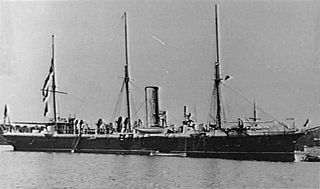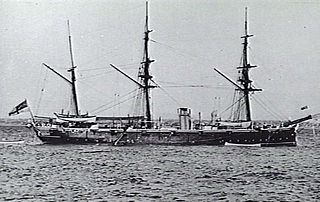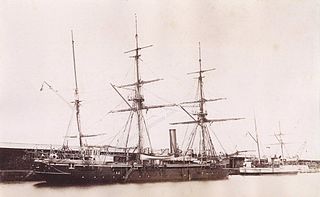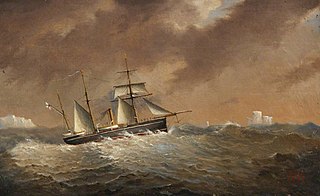
HMS Mildura was an Pearl-class cruiser built for the Royal Navy in the late 1880s. Originally named HMS Pelorus, she was renamed after an Australian town in April 1890. Per the Imperial Defense Act of 1887, she served primarily in Australian waters.

HMS Royal Arthur was a first class cruiser of the Edgar class, previously named Centaur, but renamed in 1890 prior to launching. She served on the Australia Station and briefly on the North America and West Indies Station before returning to the Home Fleet in 1906. She was paid off after the First World War.

HMS Penguin was an Osprey-class sloop. Launched in 1876, Penguin was operated by the Royal Navy from 1877 to 1881, then from 1886 to 1889. After being converted to a survey vessel, Penguin was recommissioned in 1890, and operated until 1908, when she was demasted and transferred to the Australian Commonwealth Naval Forces for use as a depot and training ship in Sydney Harbour. After this force became the Royal Australian Navy, the sloop was commissioned as HMAS Penguin in 1913. Penguin remained in naval service until 1924, when she was sold off and converted into a floating crane. The vessel survived until 1960, when she was broken up and burnt.

HMS Mohawk was an Archer-class torpedo cruiser of the Royal Navy, built by J. & G. Thompson at Glasgow and launched on 6 February 1886.

HMS Porpoise was an Archer-class torpedo cruiser of the Royal Navy, built by J. & G. Thompson at Glasgow and launched on 7 May 1886.

HMS Curacoa was a Comus-class corvette of the Royal Navy, built by John Elder & Co., Govan, launched in 1878, and sold in 1904 to be broken up. She served on the Cape of Good Hope and West Africa Station, the Australia Station and as a training cruiser in the Atlantic.

HMS Raven was a Banterer-class gunboat of the Royal Navy, built by Samuda Brothers of Poplar, London, and launched on 18 May 1882. She served on the Australia Station and was converted to a diving tender in 1904. After being lent as a training ship in 1913 she was sold for breaking in 1925.

HMS Pylades was a Satellite-class composite screw sloop of the Royal Navy, built at Sheerness Dockyard and launched on 5 November 1884. She was later reclassified as a corvette and was the last corvette built for the Royal Navy until the Second World War.

HMS Rapid was a Satellite-class composite screw sloop of the Royal Navy, built at Devonport Dockyard and launched on 21 March 1883. She was later reclassified as a corvette.

HMS Katoomba was a Pearl-class cruiser built for the Royal Navy, originally named HMS Pandora, built by Armstrong Whitworth, Elswick, Tyne and Wear and launched on 27 August 1889. Renamed on 2 April 1890, as Katoomba as the flagship of the Auxiliary Squadron of the Australia Station. She arrived in Sydney with the squadron on 5 September 1891. She was damaged in a collision with the tug Yatala in Port Adelaide on 29 December 1891. She left the Australia Station on 16 January 1906. She was sold for £8500 on 10 July 1906 and broken up at Morecambe.

HMS Boomerang was an Sharpshooter-class torpedo gunboat of the Royal Navy, originally named HMS Whiting, built by Armstrong Whitworth, Elswick, Tyne and Wear and launched on 24 July 1889. Renamed Boomerang on 2 April 1890, she formed part of the Auxiliary Squadron of the Australia Station.

HMS Ringarooma was a Pearl-class cruiser of the Royal Navy, originally named HMS Psyche, built by J & G Thomson, Glasgow and launched on 10 December 1889. Renamed on 2 April 1890, as Ringarooma as part of the Auxiliary Squadron of the Australia Station. She arrived in Sydney with the squadron on 5 September 1891. She was damaged after running aground on a reef at Makelula Island, New Hebrides on 31 August 1894 and was pulled off by the French cruiser Duchaffault. Between 1897 and 1900 she was in reserve at Sydney. On 15 February Captain Frederick St. George Rich was appointed in command. She left the Australia Station on 22 August 1904. She was sold for £8500 in May 1906 to Forth Shipbreaking Company for breaking up.

HMS Tauranga was a Pearl-class cruiser of the Royal Navy. The vessel was originally named Phoenix and built by J & G Thomson, Glasgow. She was launched on 28 October 1889. Renamed on 2 April 1890, as Tauranga as part of the Auxiliary Squadron of the Australia Station. She arrived in Sydney with the squadron on 5 September 1891. During the Samoan civil war in 1899, she took part in operations with HMS Porpoise and HMS Royalist. Spending between 1901 and 1903 in reserve at Sydney before being assigned to the New Zealand division of the Australia Station. She left the Australia Station on 14 December 1904. She was sold for £8500 in July 1906 to Thomas Ward for breaking up.

HMS Wallaroo was a Pearl-class cruiser built for the Royal Navy, originally named HMS Persian, built by Armstrong Whitworth, Elswick, Tyne and Wear and launched on 5 February 1890.

HMS Rambler was an Algerine-class gunvessel of the Royal Navy, built by John Elder & Co., Glasgow and launched on 26 January 1880. She was commissioned as a survey vessel in 1884 and served in Chinese waters during the 1880s and 1890s. She provided men to a naval brigade during the Boer War and was sold on 23 January 1907.

HMS Goldfinch was a Redbreast-class gunboat of the Royal Navy, built at Sheerness Dockyard and launched on 18 May 1889.

HMS Cambrian was a second-class protected cruiser, of the Royal Navy, built at the Pembroke Dockyard and launched on 30 January 1893. She was the last flagship of the Australia Station.

HMS Ringdove was a Redbreast-class gunboat of the Royal Navy, built at Devonport Dockyard and launched on 30 April 1889.

HMS Lizard was a Bramble-class screw gunboat of the Royal Navy, built by Harland & Wolff, Belfast and launched on 27 November 1886.

HMS Mutine was a Condor-class sloop of the Royal Navy. Mutine was launched on 1 March 1900. While being delivered from Birkenhead to Portsmouth an accident in Mutine's boiler rooms caused some loss of life and gave her a name as an unlucky ship before her career even began. She served on the China Station, then the Australia Station between December 1903 and February 1905 and later became a survey ship, surviving until 1932 as a Royal Naval Volunteer Reserve drill ship, the last of her class to be sold.





















